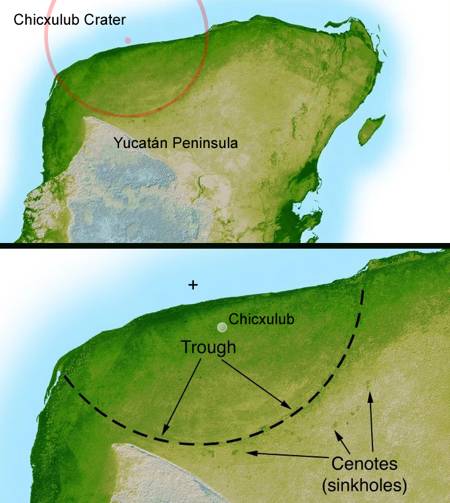What Wiped Out the Dinosaurs? Part 1: The Cause
In 1980, Luis Alvarez, winner of the 1968 Nobel Prize in physics, and his geologist son, Walter, touched off a controversy when they suggested they had discovered what killed the dinosaurs.
They claimed their detection of iridium enrichment at the Cretaceous-Paleogene (K-Pg) boundary (65.5 million years ago) implied that an asteroid, approximately 10 kilometers (6 miles) in diameter, struck Earth and led to the demise of the dinosaurs1 and over half of all other species on Earth. During the thirty years since Alvarez’s announcement, scientific opinion has remained divided over whether this mass extinction was caused by an asteroid or by a series of super volcanic eruptions spread over 1.5 million years that occurred on the Deccan plateau (now west central India).
Theological implications complicate the debate and certainly fuel much of the emotion behind it. Volcanic eruptions spread over 1.5 million years would be much less of a shock to life than a single giant impactor releasing, within a few hours, the energy equivalent to more than ten billion Hiroshima-sized atomic bombs. If more than half of Earth’s species were suddenly wiped out only to be replaced shortly thereafter with radically different life-forms designed to more efficiently remove greenhouse gases from the atmosphere and perfectly compensate for the Sun’s increasing luminosity,2 then it is difficult, if not impossible, to avoid concluding that God’s hand was behind it all. It is also difficult to get around concluding that the Bible accurately predicted future scientific discoveries when the psalmist, in reference to Earth’s life, declared:
Recently a panel of 41 scientists from 12 countries and 10 different scientific disciplines has carefully reviewed over 20 years worth of research findings to finally settle the row.4 That an asteroid collision occurred approximately 65 million years ago was never in doubt. An ancient impact crater dated at that time lies buried underneath the Yucatán Peninsula in Mexico (see image below). It measures between 180 to 200 kilometers (112 to 124 miles) in diameter.5 In analyzing data from more than 350 known K-Pg boundary sites the team demonstrated that all these sites “show a distinct ejecta distribution pattern related to distance from the Chicxulub crater.”6 In response to the assertion that the Chicxulub impactor preceded the K-Pg mass extinction event by about 300,000 years,7 they note that “orbital cycles in deep-sea sites demonstrate that there is neither a proposed global 300-thousand-year gap nor a hiatus between the Chicxulub impact and the K-Pg boundary.”8 On the other hand, the Deccan flood basalt volcanism predominantly takes place during the several hundred thousands of years before the K-Pg event.

Core drills and radar topography reveal a 65-million-year-old crater ring that measures slightly more than 180 kilometers (112 miles) in diameter.
Credit: NASA/Caltech-JPL
The research panel also disputed the claim that multiple time-separated impacts brought about the K-Pg extinction event. In their words, “The pattern of decreasing ejecta-layer thickness with increasing distance from the impact crater is consistent with the Chicxulub impact as the unique source for the ejecta in the K-Pg boundary event deposit.”9 An independent study led by geologist Kenneth MacLeod concluded, “Sedimentological, geochemical, and paleontological changes across the boundary closely match patterns expected for a mass extinction caused by a single impact. …There are no other spherule layers in the section.”10
In their exhaustive review of the evidence, the international panel swept away any remaining doubt about the cause of the K-Pg mass extinction event. The culprit, as Alvarez claimed, was an asteroid measuring at least 10 kilometers in diameter. The physical and chemical effects of this collision event, what those effects mean for Earth’s life, and the debates over creation and evolution will be discussed in part 2 of this series.
| Part 1 | Part 2 |
Endnotes
- Luis W. Alvarez et al., “Extraterrestrial Cause for the Cretaceous-Tertiary Extinction,” Science 208 (June 6, 1980): 1095–1108.
- Hugh Ross, “The Faint Sun Paradox,” Facts for Faith, no. 10, third quarter 2002, 26–33; Hugh Ross, More Than a Theory (Grand Rapids: Baker, 2009): 156–60.
- Psalm 104:29–30.
- Peter Schulte et al., “The Chicxulub Asteroid Impact and Mass Extinction at the Cretaceous-Paleogene Boundary,” Science 327 (March 5, 2010): 1214–18.
- Alan R. Hildebrand et al., “Chicxulub Crater: A Possible Cretaceous/Tertiary Boundary Impact Crater on the Yucatán Peninsula, Mexico,” Geology 19 (September 1991): 867–71.
- Schulte et al., 1214.
- G. Keller et al., “Multiple Impacts across the Cretaceous-Tertiary Boundary,” Earth-Science Reviews 62 (September 2003): 327–63.
- Schulte et al., 1216.
- Schulte et al., 1215.
- Kenneth G. MacLeod et al., “Impact and Extinction in Remarkably Complete Cretaceous-Tertiary Boundary Sections from Demerara Rise, Tropical Western North Atlantic,” Geological Society of America Bulletin 119 (January/February 2007): 101.





